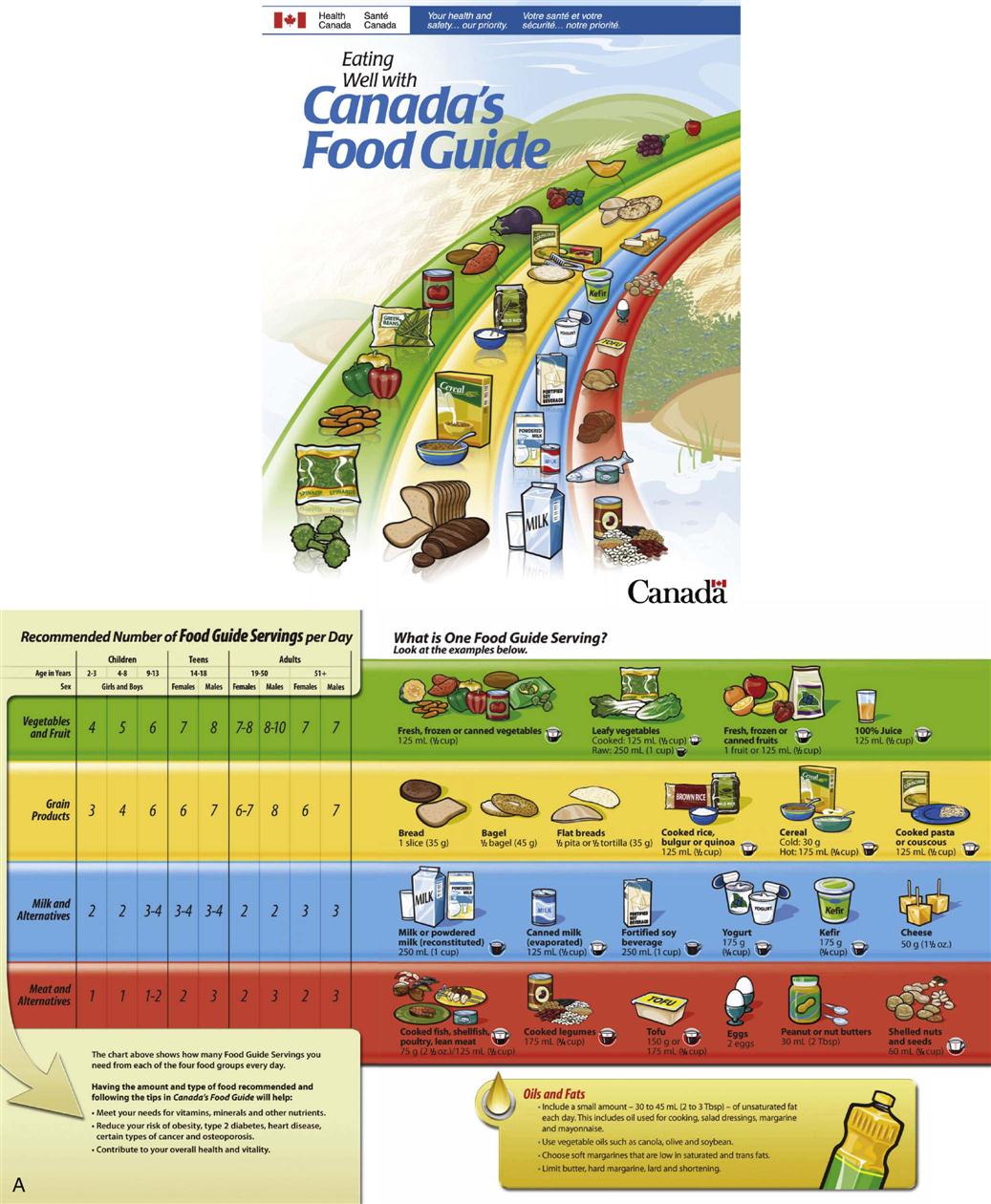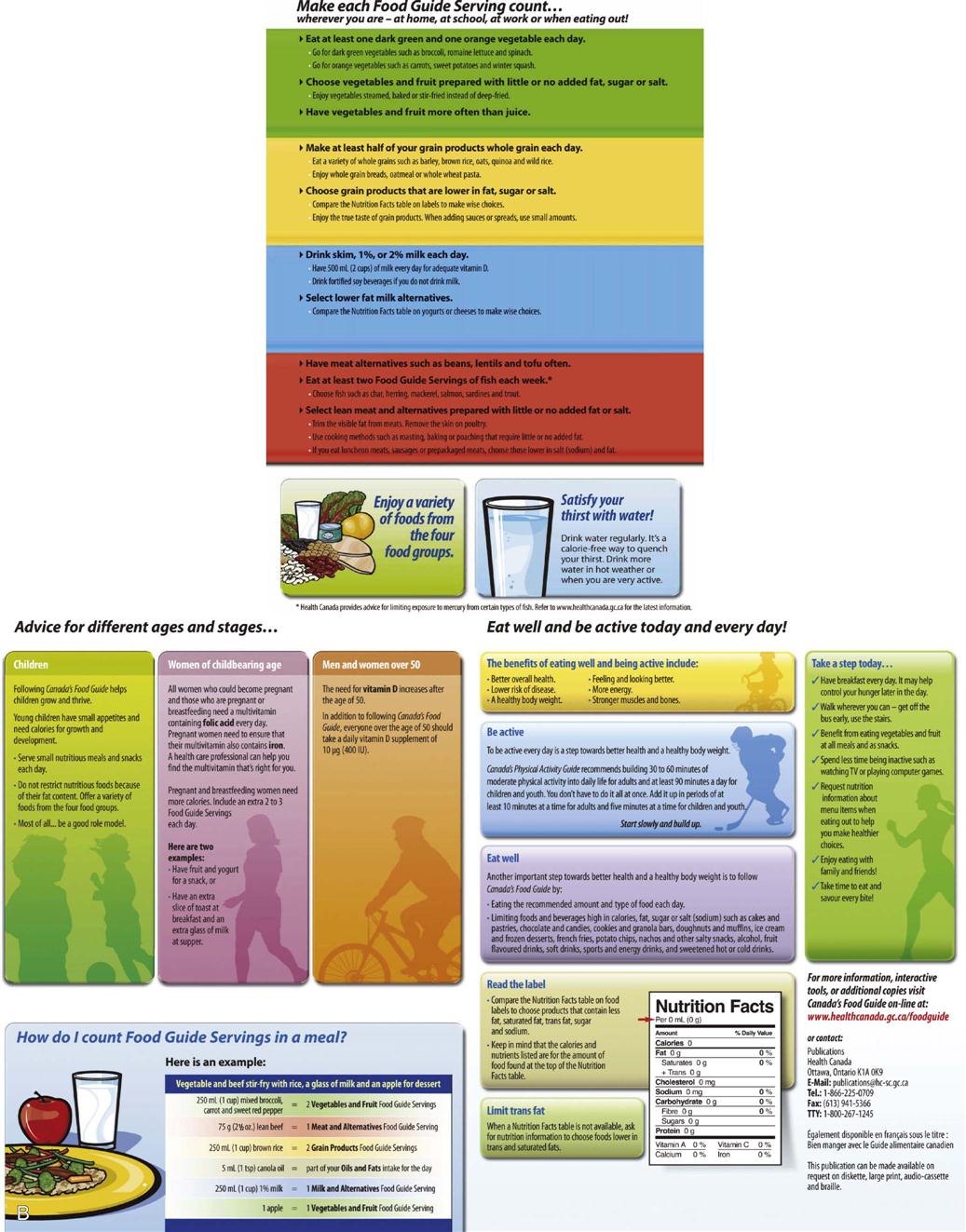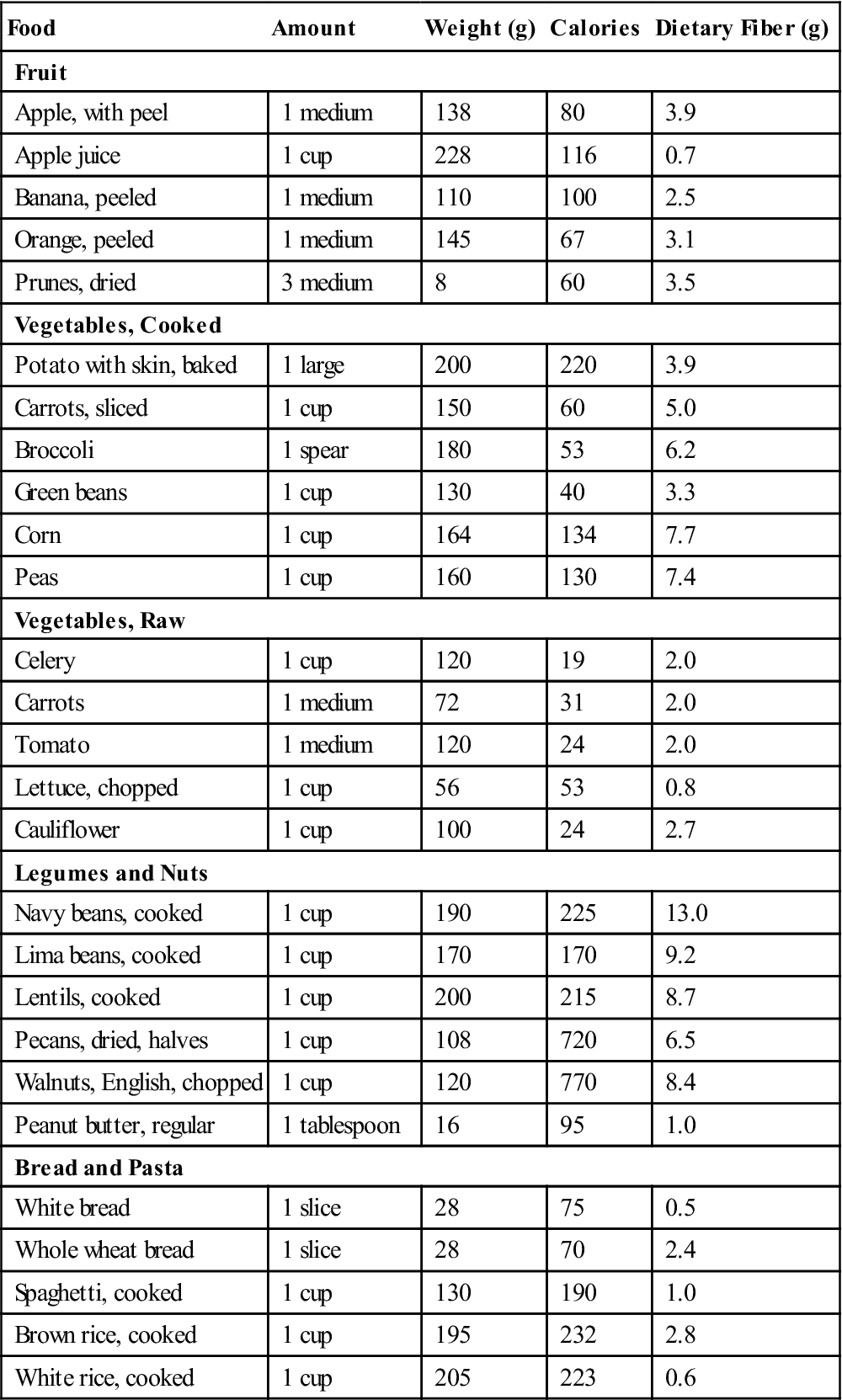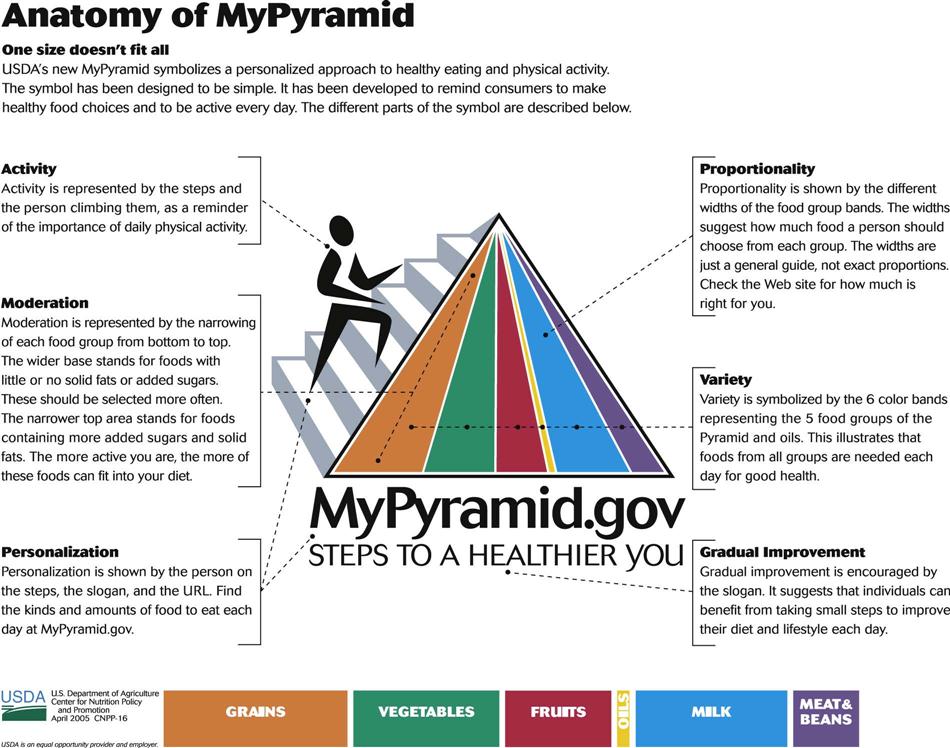Nutrition
Learning Outcomes
On completion of this chapter, the student will be able to achieve the following objectives:
• Pronounce, define, and spell the Key Terms.
• Discuss the components of the Healthy People 2020 Report.
• Explain how diet and nutrition can affect oral conditions.
• Explain why the study of nutrition is important to the dental assistant.
• Describe the three types of proteins.
• List the six areas of MyPyramid.
• Explain Canada’s food guide rainbow.
• Describe the difference between vitamins and minerals.
• Describe the role of carbohydrates in the daily diet.
• Explain the need for minerals in the diet.
• Discuss the health and oral implications of eating disorders.
• Explain how to interpret food labels.
• Explain the criteria that must be met for a food to be considered “organic.”
• Explain the relationship between frequency and quantity of cariogenic foods in causing tooth decay.
Electronic Resources
![]() Additional information related to the content in Chapter 16 can be found on the companion Evolve Web site.
Additional information related to the content in Chapter 16 can be found on the companion Evolve Web site.
Key Terms
Amino (uh-MEE-noe) acids Compounds in proteins used by the body to build and repair tissue.
Anorexia nervosa (an-uh-REK-see-uh nur-VOE-suh) Eating disorder caused by an altered self-image.
Bulimia (buh-LEE-mee-uh) Eating disorder characterized by binge eating and self-induced vomiting.
Cariogenic Producing or promoting tooth decay.
Fats Lipids.
Nutrients (NOO-tree-ents) Organic and inorganic chemicals in food that supply energy.
Organic (or-GAN-ik) Describes food products that have been grown without the use of chemical pesticides, herbicides, or fertilizers.
Triglycerides Neutral fats.
You probably have heard the expression, “You are what you eat.” This is true, because food is used to build and repair the body. Food choices therefore must be based on sound information and knowledge.
Although good nutrition is important for everyone, it is particularly critical for pregnant women, young children, and elderly persons. Malnutrition during these crucial periods may result in physical or mental disabilities. Well-nourished persons usually are better able to heal and ward off infection than are poorly nourished individuals.
As a dental assistant, you will be discussing nutrition and food choices with patients in a variety of circumstances (Fig. 16-1), including the following situations:
• Counseling patients about the prevention of tooth decay
• Counseling patients regarding their diet after oral surgery or other dental procedures
• Performing dietary analysis with patients
• Counseling patients who have orthodontic appliances regarding food choices
The study of nutrition is the science of how the body uses food for development, growth, repair, and maintenance. Nutrients are the components of food that are needed by the body.
This chapter discusses the six primary nutrients, new dietary guidelines, antioxidants, food labels, and “right” eating habits for your patients and yourself (Box 16-1).
Healthy People 2020 Report
Every ten years, the U.S. Department of Health and Human Services (USDHHS) provides science-based Healthy People reports. These reports describe the national goals and objectives for improving the health of all Americans. The Healthy People 2010 Report focused on promoting health and disease prevention and improve the disparities in health between diverse population groups (Box 16-2).
The Healthy People 2020 Report focuses attention to the root causes of health disparities, specifically general health status, health-related quality of life and well being, and disparities in health. See www.healthypeople.gov/ for details.
NutrientRecommendations
Today, there are fewer people with a healthy weight and an increase in adults, children, and adolescents who are overweight. There is also an increase in children with dental caries. The current recommendations for amounts of required nutritients have undergone significant changes in recent years, and the revised sets of nutrient-based reference values is collectively referred to as the Dietary Reference Intakes (DRIs).
Dietary Reference Intakes (DRIs)
The DRIs are developed by an expert group of scientists and registered dietitians from the United States and Canada working with the Food and Nutrition Board of the Institute of Medicine, National Academy of Sciences. The goal of the current DRIs is to improve long-term health by reducing the risk of chronic diseases, such as heart disease, osteoporosis, and cancer, that are affected by nutrition. The DRIs include recommended intakes and tolerable upper intake levels. There are four categories of nutrient-based reference values for various stages of life.
The DRIs are intended for planning and assessing diets of healthy Americans and Canadians. The DRIs are inappropriate for individuals who are malnourished or patients who have diseases that require special nutrition. The DRIs represent a shift in emphasis from preventing deficiencies to reducing the risk of chronic disease through nutrition.
Recommended Dietary Allowances (RDAs)
The Recommended Dietary Allowances (RDAs) focus on the amount of essential nutrients needed on a daily basis to prevent deficiency diseases. The RDA value of a nutrient is based on the amount of that particular nutrient necessary to prevent a deficiency.
Dietary Guidelines for Americans
Because of new scientific information related to nutrition, the Dietary Guidelines for Americans are revised every 5 years. These guidelines are intended to promote health and help prevent or reduce the incidence of chronic disease. They include nine focus areas with 23 key recommendations regarding food intake and energy expenditure.
MyPyramid
The U.S. Department of Agriculture (USDA) in 2005 released an updated guidance system that replaces the previous food pyramid, which was created in 1992. The new “MyPyramid” icon consists of six panels that represent grains; vegetables; fruits; milk; meat and beans; and fats, sugars, and salts. Each step up the pyramid indicates a smaller overall calorie intake; however, the recommended ration of each food group consumed remains constant. According to MyPyramid, most servings should come from grains, followed closely by milk, then vegetables and fruits. Meat and beans should be lean and varied. Fats, sugars, and salt should be consumed sparingly.
The USDA has a Web page (www.mypyramid.gov) that gives consumers basic messages about healthful eating and physical activity that apply to everyone (Fig. 16-2). The Web site allows you to enter your age, gender, and activity level. You can then print out a personalized miniposter of your own plan at the appropriate calorie level. The food plan includes specific daily quantities from each food group and a limit for discretionary calories (fats, sugars, alcohol). You can also print out a worksheet that you can use to track your progress and choose goals for tomorrow and the future.
You can discuss MyPyramid with patients to help them understand how to achieve healthful eating habits. Eating a healthful diet is necessary for looking better, feeling better, having more energy, and developing a more positive outlook on life.
Canada’s Food Guide
Canada has developed a pictorial food guide to assist Canadians to choose food wisely (Fig. 16-3). The Food Guide Rainbow encourages consumers to determine their own healthy lifestyle—a pot of gold. The Web site (www.hc-se.gc.ca/fn-an/food-guide-aliment/index-eng.php) allows consumers to personalize the food guide, providing recipes, tips for healthy eating and physical activity, and other educational materials.


Carbohydrates
Carbohydrates are primarily plant products in origin. No animal sources are available that provide adequate carbohydrates. Carbohydrates are easily converted to energy, and the body uses them as the chief source of energy.
Carbohydrates are divided into three groups according to the complexity of their molecules: simple sugars, complex carbohydrates (starch), and dietary fiber. With the exception of fiber, carbohydrates are easily digested and absorbed into the body. Simple sugars are absorbed first; complex sugars must be processed before they can be absorbed into the intestinal tract. Dietary fiber is indigestible and passes through the intestinal tract unchanged. Each group has a specific function in health.
Dietary fiber is commonly called roughage. It is the portion of the plant that is eaten but cannot be absorbed. Fiber is classified by its water solubility. Roughage adds bulk to the intestinal tract and is beneficial for normal gastrointestinal functioning. Water-soluble fiber, which is found in oat bran, fruits, and vegetables, helps to lower cholesterol. Insoluble fiber, which is found in whole grains and beans, helps to prevent colon cancer and may reduce risk of heart attack (Table 16-1).
TABLE 16-1
Dietary Fiber in Some Common Foods
< ?comst?>
| Food | Amount | Weight (g) | Calories | Dietary Fiber (g) |
| Fruit | ||||
| Apple, with peel | 1 medium | 138 | 80 | 3.9 |
| Apple juice | 1 cup | 228 | 116 | 0.7 |
| Banana, peeled | 1 medium | 110 | 100 | 2.5 |
| Orange, peeled | 1 medium | 145 | 67 | 3.1 |
| Prunes, dried | 3 medium | 8 | 60 | 3.5 |
| Vegetables, Cooked | ||||
| Potato with skin, baked | 1 large | 200 | 220 | 3.9 |
| Carrots, sliced | 1 cup | 150 | 60 | 5.0 |
| Broccoli | 1 spear | 180 | 53 | 6.2 |
| Green beans | 1 cup | 130 | 40 | 3.3 |
| Corn | 1 cup | 164 | 134 | 7.7 |
| Peas | 1 cup | 160 | 130 | 7.4 |
| Vegetables, Raw | ||||
| Celery | 1 cup | 120 | 19 | 2.0 |
| Carrots | 1 medium | 72 | 31 | 2.0 |
| Tomato | 1 medium | 120 | 24 | 2.0 |
| Lettuce, chopped | 1 cup | 56 | 53 | 0.8 |
| Cauliflower | 1 cup | 100 | 24 | 2.7 |
| Legumes and Nuts | ||||
| Navy beans, cooked | 1 cup | 190 | 225 | 13.0 |
| Lima beans, cooked | 1 cup | 170 | 170 | 9.2 |
| Lentils, cooked | 1 cup | 200 | 215 | 8.7 |
| Pecans, dried, halves | 1 cup | 108 | 720 | 6.5 |
| Walnuts, English, chopped | 1 cup | 120 | 770 | 8.4 |
| Peanut butter, regular | 1 tablespoon | 16 | 95 | 1.0 |
| Bread and Pasta | ||||
| White bread | 1 slice | 28 | 75 | 0.5 |
| Whole wheat bread | 1 slice | 28 | 70 | 2.4 |
| Spaghetti, cooked | 1 cup | 130 | 190 | 1.0 |
| Brown rice, cooked | 1 cup | 195 | 232 | 2.8 |
| White rice, cooked | 1 cup | 205 | 223 | 0.6 |
< ?comen?>< ?comst1?>

< ?comst1?>
< ?comen1?>
From Applegate E: The anatomy and physiology learning system, ed 4, St Louis, 2011, Saunders.
Complex carbohydrates, which are found mainly in grains, vegetables, and fruits, are important because they provide energy. Foods high in complex carbohydrates also supply vitamins, minerals, and fiber. Although fiber is not classified as a nutrient, it is essential for good health.
Simple sugars are formed in the mouth from refined carbohydrates that are found in processed foods such as sugar, syrup, jelly, bread, crackers, cookies, candy, cake, and soft drinks. In contrast to complex carbohydrates, most refined carbohydrates supply only “empty” calories, and many are high in fat. Empty calories are those that provide only calories and no other nutrients or fiber.
Although it may be wise to lower dietary fat, consumers should be cautioned to read food labels carefully. In many low-fat or reduced-fat foods, fat is replaced with sugars. As a result, although the fat content of a food may be less, the calorie count may be the same or higher than that in the original higher-fat version of the food.
Foods That Cause Tooth Decay
Any food that contains sugars or other carbohydrates that can be metabolized by bacteria in plaque is described as cariogenic (producing or promoting dental decay). For instance, refined carbohydrates, such as candy and other sweets, are cariogenic (Table 16-2).
Stay updated, free dental videos. Join our Telegram channel

VIDEdental - Online dental courses




